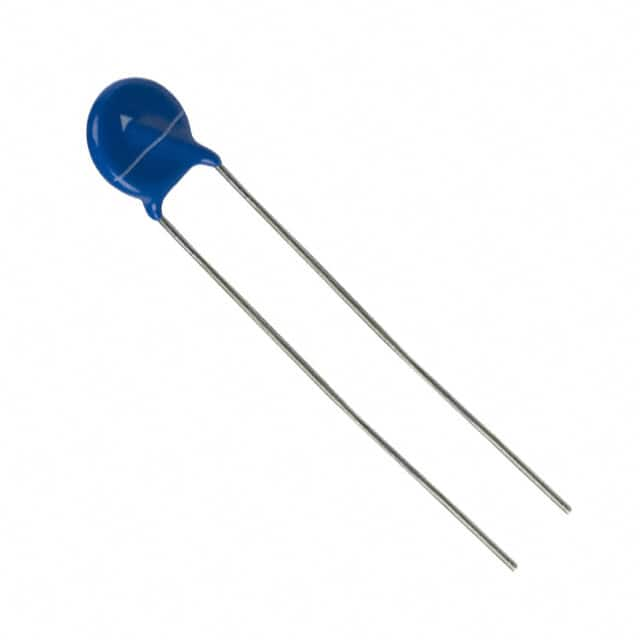B72207S0131K211 Product Overview
Introduction
The B72207S0131K211 is a component belonging to the category of varistors, commonly used for voltage clamping and transient surge protection in electronic circuits. This entry provides an overview of the basic information, specifications, pin configuration, functional features, advantages and disadvantages, working principles, application field plans, and alternative models of the B72207S0131K211.
Basic Information Overview
- Category: Varistors
- Use: Voltage clamping and transient surge protection
- Characteristics: High energy absorption capacity, fast response time, compact size
- Package: Disc type
- Essence: Zinc oxide-based ceramic material
- Packaging/Quantity: Available in tape and reel packaging, quantity varies by manufacturer
Specifications
- Voltage Rating: 130V
- Nominal Discharge Current (8/20µs): 3000A
- Maximum Energy (10/1000µs): 2.5J
- Operating Temperature Range: -40°C to +85°C
- Lead Material: Tin-plated copper
Detailed Pin Configuration
The B72207S0131K211 varistor has a disc-shaped body with two axial leads for connection to the circuit. The pin configuration is as follows: - Lead 1: Anode - Lead 2: Cathode
Functional Features
- Voltage Clamping: Provides protection by diverting excessive current when the voltage exceeds the threshold.
- Transient Surge Protection: Absorbs and dissipates transient surge energy to safeguard sensitive electronic components.
Advantages and Disadvantages
Advantages
- High energy absorption capacity
- Fast response time
- Compact size
- Reliable transient surge protection
Disadvantages
- Limited lifespan under repetitive high-energy surges
- Susceptible to thermal aging effects
Working Principles
The B72207S0131K211 operates based on the non-linear voltage-current characteristics of zinc oxide varistors. When subjected to overvoltage conditions, the varistor conducts current, limiting the voltage across the protected circuit.
Detailed Application Field Plans
The B72207S0131K211 finds applications in various electronic systems requiring transient surge protection, including: - Power supplies - Telecommunication equipment - Industrial control systems - Consumer electronics
Detailed and Complete Alternative Models
Several alternative models are available in the market, offering similar transient surge protection capabilities. Some notable alternatives include: - Bourns® CDSOD323-T05LC - Littelfuse® V22ZA3P - TDK Electronics™ EPCOS S14K130
In conclusion, the B72207S0131K211 varistor serves as a crucial component in protecting electronic circuits from transient surges and overvoltage events. Its high energy absorption capacity, fast response time, and compact design make it a preferred choice for various applications.
Word Count: 410
قم بإدراج 10 أسئلة وإجابات شائعة تتعلق بتطبيق B72207S0131K211 في الحلول التقنية
What is B72207S0131K211?
- B72207S0131K211 is a specific type of EPCOS varistor, commonly used for overvoltage protection in technical solutions.
How does B72207S0131K211 work?
- B72207S0131K211 works by rapidly changing its resistance in response to changes in voltage, effectively diverting excess current away from sensitive components.
What are the typical applications of B72207S0131K211?
- B72207S0131K211 is commonly used in power supplies, automotive electronics, industrial equipment, and telecommunications systems for surge protection.
What are the key specifications of B72207S0131K211?
- The key specifications include a maximum AC voltage of 130V, a maximum DC voltage of 175V, and a maximum surge current capability of 6000A.
How do I select the right B72207S0131K211 for my application?
- The selection process involves considering the operating voltage, surge current requirements, and environmental conditions to ensure optimal performance.
Are there any precautions to consider when using B72207S0131K211?
- It's important to follow proper handling procedures, avoid mechanical stress, and adhere to recommended operating conditions to prevent damage or malfunction.
Can B72207S0131K211 be used in high-temperature environments?
- Yes, B72207S0131K211 is designed to operate within a wide temperature range, making it suitable for various industrial and automotive applications.
What are the advantages of using B72207S0131K211 over other varistors?
- B72207S0131K211 offers high surge current capability, low leakage current, and excellent reliability, making it a preferred choice for many technical solutions.
Is B72207S0131K211 RoHS compliant?
- Yes, B72207S0131K211 complies with the Restriction of Hazardous Substances (RoHS) directive, meeting environmental standards.
Where can I purchase B72207S0131K211?
- B72207S0131K211 can be purchased from authorized distributors or directly from the manufacturer, ensuring genuine and reliable components for your technical solutions.


